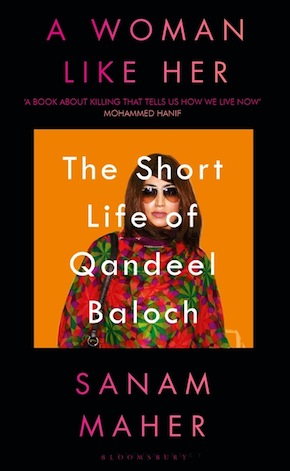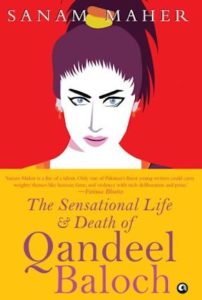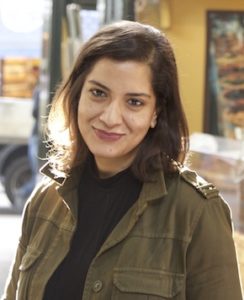Sanam Maher: The real Qandeel?
by Mark Reynolds
“Only one of Pakistan’s finest young writers could carry weighty themes like honour, fame and violence with such deliberation and poise.” Fatima Bhutto
Qandeel Baloch was the social-media siren who teased and titillated Pakistani society with her pouty posts and racy videos, empowering young women and outraging religious elders at every turn. Her highlights reel is well known: the failed audition on Pakistan Idol – all shrill voice, shocking pink leggings and fake tears; the stunt marriage proposal to Imran Khan; the promise to strip for the Pakistan cricket captain if the team beats India; the sexy selfies with middle-aged Muslim cleric Mufti Abdul Qavi; the ‘adults only’ pop video. Then at the height of her notoriety the media uncovered her humble beginnings in rural Punjab, offering up her true identity and revealing that she had run away from an abusive arranged marriage to her mother’s cousin, leaving behind an estranged son. Within weeks she was dead, killed by her own brother who accused her of bringing shame on the family.
Sanam Maher’s A Woman Like Her: The Short Life of Qandeel Baloch probes the obstacles and instincts that shaped Qandeel’s mercurial rise to risqué stardom, and the media frenzy that motivated her brother Waseem – and indeterminate accomplices – to murder her. But above all she examines the irrational response of voyeuristic indignation Qandeel’s actions provoked throughout Pakistani society and the world’s media. Via interviews with family members and friends, news reporters, TV chat show hosts, activists, police investigators, lawyers, and Mufti Qavi himself, Maher pieces together a potent and enduring study of independence, identity, abandon, self-promotion, and the nature of female celebrity in the digital age where it rubs up against patriarchal control and twisted notions of honour.
“Qandeel’s every appearance, video, interview, tweet or Facebook post was in character,” she writes. “She created a story about herself – part truth and part lies and exaggerations. The story allowed her to be whoever we wanted her to be, and the small fibs are as much a part of the real story of Qandeel – if not more important – as the filtered memories of her friends and family.”
MR: So what do people think when they think of Qandeel?
SM: If we consider what the majority of Pakistanis who followed her on social media thought about her, a quick scroll through some of the comments gives us a pretty accurate picture. Here are two of the most common: “She is the official slut of Pakistan”, “She is destroying the image of a Pakistani in front of the world… specially she is destroying the image of women.” She confused and enraged these people – they could not understand what kind of woman would behave the way that she did and not retreat from social media in the face of the kind of vitriol she faced every day for posting her photos and videos. What kind of woman – specifically a Muslim, Pakistani woman – would not feel shame?
Pakistani women seem to bear the weight of expectations when it comes to determining how we would like the world to view us and Qandeel was no exception.”
I started this answer by considering these people since I believe this tide of outrage towards Qandeel is one of the reasons she isn’t alive. Pakistan is notably obsessed with its ‘image’, and the question of who is good enough to represent the nation or what face we should show the world has dogged us for decades. We’re seeing that manifest once more right now as women add their voices to the #MeToo movement, only to have their detractors accuse them of trying to “shame” Pakistan or “bring a bad name” to the country. Pakistani women seem to bear the weight of expectations when it comes to determining how we would like the world to view us and Qandeel was no exception. The most common reaction to anyone who seems to challenge a positive view of Pakistan is to want to silence them, to erase them from that picture. I often think of a local TV interview Qandeel did a few months before she was killed, where an actress who was on the same talk show said, “No one should follow her. People like her should just be made to disappear.”
Many people, particularly young women, drew strength from Qandeel. In Multan, where Qandeel was murdered, I met two young female journalists who had watched a BBC interview where she was filmed swimming in a pool with other men present – it’s such a small act, a refusal to feel ashamed or to stick to the norms of how young women are supposed to behave, but it made them admire how fearless she seemed to be.
Before she died, the international media knew her as “the Kim Kardashian of Pakistan”. After she died, she was embraced by this media as a feminist icon: Qandeel became a woman who celebrated her body, she “gave voice to a generation of Pakistani women”, she was “a role model”, “an incredibly fearless Pakistani women’s rights campaigner who had zero fucks left to give”, “a one-woman revolution against religiously and culturally justified misogyny”. Such praise was absent during her life.
How have your own impressions of her changed since her murder?
I think I knew in some abstract, logical way that she had a great deal of courage and ambition, to come from nothing and to work hard to make her dream of being famous come true, to become financially independent, to become someone who may be joked about, but whose name is even mentioned in parliament because she reaches that level of recognition. But that stopped being abstract when I travelled to the village in southern Punjab where she was born and raised. In one interview, a man told me about some of the men in his community. “They do not give their women shoes,” he said. I was confused about what he meant. He explained, “Imagine you do not have shoes on your feet and you step out of the house. Where will your eyes remain? On the ground. You will never look up – never look at any man – or look around you. You will only look down.” Those interviews and being in that place completely changed the way I wanted to work on the book. I enjoyed a privilege that Qandeel and the women she knew did not: I had an audience interested in my version of their story, I had the ability to speak back to and question the men who imposed control over their life. That’s why the book has Qandeel’s own words interjecting my narrative at every turn – I used anything she had said in interviews, Facebook posts, tweets, YouTube videos and live chats in order to keep her voice present throughout, to question the reader’s perspective. There are actually many sentences or phrases throughout the book that are entirely Qandeel’s, not mine. They run through the book and many readers may not pick up on them but it was a small way I tried to make sure I was not speaking on behalf of someone who did not enjoy that privilege while she was alive.
Only changing legislation will not lead to a sudden decrease in the number of honour killings in Pakistan. This is a cultural problem.”
What does a feminist icon look like in Pakistan, and what can they hope to achieve?
I don’t believe they look or behave differently from a feminist anywhere else in the world or care about different things. What is a ‘feminist icon’ anyway? I’d be wary of anyone who describes themselves as an icon and who embraces that label. Qandeel isn’t interesting to me because she was anointed an icon after her death – I’m curious about why we struggled to even recognise her as a feminist while she was alive.
What can feminists hope to achieve? Here in Pakistan and anywhere in the world – everything.
Soon after Qandeel’s murder, Pakistan legislated to close the loophole that allows killers to walk free if they are pardoned by family members. What difference has that made in this case and in Pakistan generally? Has the rate of honour killings actually gone down? And where is Waseem today?
Qandeel’s case continues and Waseem is in jail during the trial. Some say the international attention Qandeel’s murder got and the government’s eagerness to demonstrate that it was taking this case seriously would mean the trial would be quick – it has been three years and there’s no verdict yet. Although I suppose that could be described as ‘quick’ in a country where last year it was reported that over 1.8 million cases are pending in all courts (from sessions courts to the Supreme Court), with one gentleman still chasing a case from the 1960s.
Only changing legislation will not lead to a sudden decrease in the number of honour killings in Pakistan. This is a cultural problem, and to think that putting someone behind bars for a murder they committed to avenge ‘honour’ fails to consider that often being in jail elevates the murderer’s status in his or her community – after all, if someone takes their ‘self-respect’ and ‘honour’ so seriously that they’re willing to spend life in prison to protect it, isn’t that person admirable in the eyes of those who put stock in those notions? Human Rights Watch estimated in 2017, after the loophole in the law pertaining to honour killings was closed, that about 1,000 honour killings took place that year. Meanwhile, the Human Rights Commission of Pakistan says that at least 419 people were killed for honour in 2018, down from 919 in 2012. The numbers vary because lawyers and activists say that it is becoming increasingly difficult to keep tabs on honour crimes as those committing them know the loophole in the law is closed – they cover up these crimes, lie to police about their motivations, and when a family or community is complicit in an honour crime, they will stick together to hide what might have really happened. Only 2% of honour killing suspects were convicted in the last year – there are lapses at every level, whether that’s with the police investigation, the way the courts handle the cases, or the family’s refusal to have one of their own charged. Changing the law isn’t going to be a cure-all for this.
Sharmeen Obaid Chinoy’s documentary A Girl in the River played a big part in persuading Nawaz Sharif to implement the law change. What makes her film so powerful? And who else in Pakistan is campaigning effectively for change?
The film highlights the tenuous grip the concept of ‘honour’ has on men and women in Pakistan and the lengths they will go to to preserve that honour. Once A Girl in The River won an Oscar and Pakistan was suddenly in the international spotlight for something we aren’t too proud of, something that makes us look like we don’t care about our women, the government was quick to promise it would change the legislation on these crimes. I’m curious about why such interest wasn’t paid when activists in women’s rights groups such as Aurat Foundation and Women’s Action Forum and some lawmakers were pushing for this for years.
Another initiative in the wake of Qandeel’s murder was the establishment of the Violence Against Women Centre in Multan. What happened next?
Earlier this year, it was reported that staff at the Violence Against Women Centre were on strike as they had not been paid their salaries by the government for nine months, and electricity, gas and water had been cut to the centre as bills had not been paid. I think they’re still trying to find funding to make sure this isn’t a persistent problem.
How can political leaders in Islamabad – and also national and local religious leaders – hope to change customs and practices in remote villages and communities where the elders hold sway?
Some of these political leaders can stop excusing these crimes and actually work towards empowering women on every level, whether that’s access to education or employment or legal recourse. In 2008, when three teenage girls and two women were shot and then buried alive in Balochistan province for wanting to marry of their free will, a senator from that province defended what had taken place as “our tribal custom”. Many of these political leaders are also unwilling to rock the boat and call for changes that would affect their vote bank in villages where elders may warn constituents not to vote for them. The problem is across the board, and responsibility does not lie with political or religious leaders alone. In a country where 149 of the honour killings recorded between October 2016 and 2017 took place because of the victim’s “marriage choice”, it was frustrating to hear of a case from February 2017 when a judge was presented with a couple pleading for police protection after they had eloped and he scolded them for doing so. According to the judge, if “love marriages don’t succeed in films, then how will they succeed in real life?” The judge further noted, “Those who contract love marriage come in the court after some time for divorce.”
Readers messaged me on social media to tell me that at one big bookshop in the capital they kept my book behind the counter and only handed it over to customers who requested it – almost as if it were pornography!”
What kind of resistance have you had to publishing a book about Qandeel and the society that allowed her story to play out the way it did?
 I didn’t expect booksellers to have the response that they did. In Pakistan we don’t have very many independent bookshops, and without a platform like Amazon you’re dependent on larger bookshop chains to make sure your book sells. At one, I was told that they didn’t want to give me space to do any book events and if I hadn’t put Qandeel’s name in the book’s title or put her face on the book cover, they might have reconsidered. The book came out during Ramadan, and for many that was excuse enough to say they didn’t want to publicise the book – this is funny considering that the book sold out within that month in Pakistan, but evidently booksellers thought that there was no way they could have anything to do with “a woman like Qandeel” during the holy month of fasting. Readers messaged me on social media to tell me that at one big bookshop in the capital they kept my book behind the counter and only handed it over to customers who requested it – almost as if it were pornography! It angers me still that these bookshops profit from Qandeel and her story – the book is in its third reprint in South Asia – but refuse to engage with her in any meaningful way. I also had universities and libraries cancel events and book talks at the last minute, even when I said they could read the book and see that there was nothing scandalous or controversial in there. There were a few instances when I would be interviewed only to find out that the interview would not run because a senior editor did not want to give coverage to something about Qandeel. While I largely had a fantastic response from readers on social media, I do hear from people who tell me that I’m just as shameless as Qandeel because I’ve “wasted” my time writing about her, or that I’m “clearly an atheist” because no self-respecting Muslim would work on a book about Qandeel.
I didn’t expect booksellers to have the response that they did. In Pakistan we don’t have very many independent bookshops, and without a platform like Amazon you’re dependent on larger bookshop chains to make sure your book sells. At one, I was told that they didn’t want to give me space to do any book events and if I hadn’t put Qandeel’s name in the book’s title or put her face on the book cover, they might have reconsidered. The book came out during Ramadan, and for many that was excuse enough to say they didn’t want to publicise the book – this is funny considering that the book sold out within that month in Pakistan, but evidently booksellers thought that there was no way they could have anything to do with “a woman like Qandeel” during the holy month of fasting. Readers messaged me on social media to tell me that at one big bookshop in the capital they kept my book behind the counter and only handed it over to customers who requested it – almost as if it were pornography! It angers me still that these bookshops profit from Qandeel and her story – the book is in its third reprint in South Asia – but refuse to engage with her in any meaningful way. I also had universities and libraries cancel events and book talks at the last minute, even when I said they could read the book and see that there was nothing scandalous or controversial in there. There were a few instances when I would be interviewed only to find out that the interview would not run because a senior editor did not want to give coverage to something about Qandeel. While I largely had a fantastic response from readers on social media, I do hear from people who tell me that I’m just as shameless as Qandeel because I’ve “wasted” my time writing about her, or that I’m “clearly an atheist” because no self-respecting Muslim would work on a book about Qandeel.
What have been the most positive and pleasing aspects of the book’s reception?
I had a journalist from the American media organisation NPR based in Islamabad reach out and she offered to open up her home to total strangers just so I could do a book event in the city, and then many others followed suit, which was the most generous response I could have asked for from readers.
The cover for the South Asian edition features an illustration by a Lahore-based artist, Rahema Zaheer Alam, and that illustration first caught our eye when we saw women carrying posters of it at Women’s Day marches in Karachi and Lahore in 2018. The cover and that image really resonated with readers here and a wonderful trend developed on social media where people would send me pictures of the book in their cities, and this quickly grew to include readers around the world who were ordering the book from South Asia or having friends and family in this region send it to them – I think at my last count the book was photographed in 14 countries. Many young women messaged me to say that they were taking pictures of the book in different countries or travelling with the book on vacations so that Qandeel’s name and her face remained out there in the world.
It has meant a great deal to me to hear from readers who say that they had judged Qandeel or thought she was “shameless”, and they’ve changed their mind after reading the book and learning more about where she came from. Some of my favourite photographs that readers have tagged me on on social media are of their grandparents reading the book and talking about it with them. It is the most gratifying thing to have readers engage with your work in this way, and it outweighs any negative response.
How would you summarise your encounter with Mufti Qavi?
It was… long. Mufti Qavi had originally only agreed to give me 45 minutes of his time. When I met him, he was quite concerned about the court case and whether he would be summoned to talk about any role he might have played in Qandeel’s murder. In the weeks before she was killed, Qandeel had accused the cleric of behaving inappropriately with her during their meeting in a hotel room. It isn’t my job to find out what happened in that room or to engage in a he said/she said debate – he wouldn’t have been honest about that anyway. I was more interested in what happens after a man’s status and privilege is stripped away because of something a woman says about him. I wanted to see how this man processed his loss of power at the hands of a woman, the extent to which he might go to get that power back, and whether he felt accountable at all for everything that happened to her. So I understood that I needed to let Mufti Qavi speak and almost unburden. It worked: it ended up being a 6-hour interview.
I’m fed up with people in Pakistan bashing the media and accusing them of sensationalism without examining an audience that also drives that need for sensational content.”
Qandeel’s fate was sealed after the encounter with the cleric went viral and then her true identity and origins were revealed. To what extent do you feel the media are to blame for her death?
Qandeel became fair game for the Pakistani media and details about her private life, such as her divorce or the identity of her child, became public knowledge, and images of her national identity card and passport were published without consideration for what could happen to her as a result. That can only happen when she isn’t considered worthy of respect or dignity or privacy because she’s labelled a “drama queen” or “just a call girl” and it definitely set a chain of events in motion that led to her death.
But at the same time, the onus cannot just be placed on the media. Any solution to the problem of insensitive or sensational reporting has to include the editors, the men and women making decisions at media companies, but also the audience. As an audience we want to be entertained and we have an attention deficit when it comes to certain stories, and news organisations are trying to compete with everything else that’s distracting us, trying to find new ways to get ‘clicks’ and ‘likes’ and ‘shares’. As a reporter, if you aren’t catering to that need, then it’s your job on the line. I’m fed up with people in Pakistan bashing the media and accusing them of sensationalism without examining an audience that also drives that need for sensational content. We also need better oversight – our media regulatory might be a tad distracted trying to curb different content, such as any TV shows that depict “bed scenes” and “hackneyed image(s) of women (who have) confined themselves to feminist issues only… ignoring children, teenagers and men.” What does that mean? I’m just as confused as you are.
Qandeel’s parents have followed a familiar trajectory of anger, outrage and vengeance, softening to regret, forgiveness, and fear of losing another child if Waseem were sentenced to either death or life imprisonment. What would be a good outcome now for the family?
To be perfectly honest, I’m not sure. If Waseem were found guilty, they don’t just have to grapple with their feelings as parents, but also as members of a community that they are very dependent on – how would people in their village treat them if their testimony against their son led to his imprisonment for life? And how would their other children feel? – children they are now financially dependent on since Qandeel isn’t there to support them. Would they face any backlash?
Where has your journalism taken you since completing this, and can we expect another book soon?
I continue to freelance and I’m in the very early stages of researching another book. I don’t want to say anything about it just yet!
The book was originally published in India and Pakistan as The Sensational Life and Death of Qandeel Baloch. Do you have any regrets about the title change for this edition?
Not at all. The title A Woman Like Her came about during conversations at Bloomsbury, and it was a phrase that I didn’t even realise I came back to quite often when discussing what Qandeel meant to those who admired her and to her detractors. Someone at my publishers took note of that and we had a title!
Why @topbastard?
Unfortunately I don’t have a very creative reason for this – it’s a running joke with my sister for many years. As children we loved the cartoon series Top Cat, and one day, when we were complaining about how some people behave, we used the phrase ‘top bastard’. When I started my Instagram and Twitter, I ended up using that just for fun – I actually had to end up changing my Twitter handle because some places I freelance for refused to run ‘bastard’ in my byline.
 Sanam Maher is a journalist based in Karachi. For more than a decade, she has covered stories on Pakistan’s art and culture, business, politics, religious minorities and women. Her work has appeared in the New York Times, Al Jazeera, The Caravan, Roads and Kingdoms and Buzzfeed. A Woman Like Her is published in hardback and eBook by Bloomsbury.
Sanam Maher is a journalist based in Karachi. For more than a decade, she has covered stories on Pakistan’s art and culture, business, politics, religious minorities and women. Her work has appeared in the New York Times, Al Jazeera, The Caravan, Roads and Kingdoms and Buzzfeed. A Woman Like Her is published in hardback and eBook by Bloomsbury.
Read more
sanammaher.com
@SanamMKhi
@topbastard
Author portrait © Shehrezad Maher
Mark Reynolds is a freelance editor and writer, and a founding editor of Bookanista.
@bookanista
wearebookanista




